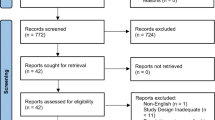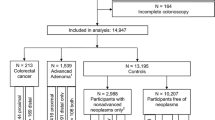Abstract
Purpose
The introduction of reimbursement for screening colonoscopy in Germany more than one year ago raised concerns that the consequent workload might lead to underuse of diagnostic colonoscopy for symptomatic patients. Available appropriateness criteria for diagnostic colonoscopy have been rarely tested in a realistic outpatient setting. This study was designed to test current appropriateness criteria for diagnostic colonoscopy to better select patients and potentially provide more capacity for screening cases. Secondary goals were yield and quality control in both the diagnostic and screening cases.
Methods
A prospective study was initiated in 39 private-practice offices to collect data on consecutive colonoscopies conducted during a 6-day study period. A detailed questionnaire was developed to define indications and symptoms, and all findings at colonoscopy were recorded. Colonoscopies were further analyzed and stratified into a screening and a diagnostic group. In the diagnostic group, indications were assessed according to the current guidelines for appropriateness (American Society for Gastrointestinal Endoscopy, European Panel for the Appropriateness of Gastrointestinal Endoscopy), and the results were correlated with the percentage of relevant findings (tumors, inflammatory conditions).
Results
During the study period, 1,397 colonoscopies (57 percent screening, 43 percent diagnostic) were analyzed (male/female ratio = 39/61 percent; mean age, 61 years). Fourteen percent and 37 percent, respectively, of the 605 diagnostic colonoscopies were regarded as inappropriate relative to the criteria of the American Society for Gastrointestinal Endoscopy and the European Panel for the Appropriateness of Gastrointestinal Endoscopy. However, the percentage of relevant inflammatory and neoplastic findings (polyps, cancer, inflammatory bowel disease, benign strictures) was only 5 to 10 percent higher in the appropriate group than in the inappropriate group. On the basis of these data, a hypothetical model for selecting appropriate indications was developed: if patients older than aged 50 years with pain, bleeding, and diarrhea, but not constipation, are regarded as having an appropriate indication, such an approach would save 20 percent of colonoscopies in these main indication groups (bleeding, pain, diarrhea, constipation), with a hypothetical miss rate for relevant findings (as defined above) of 5 percent.
Conclusions
Currently used appropriateness criteria for diagnostic colonoscopy increase the yield of relevant findings but lead to a miss rate for relevant findings in the range of 10 to 15 percent. Simple selection criteria based on age and symptoms could be more suitable and should be tested in a larger group of patients.

Similar content being viewed by others
References
Winawer SJ, Zauber AG, Ho MN, et al. Prevention of colorectal cancer by colonoscopic polypectomy. The National Polyp Study Workgroup. N Engl J Med 1993;329:1977–81.
Schmiegel W, Adler G, Frühmorgen P, et al. Colorectal carcinoma: prevention and early detection in an asymptomatic population—prevention in patients at risk—endoscopic diagnosis, therapy and after-care of polyps and carcinomas. German Society of Digestive and Metabolic Diseases/Study Group for Gastrointestinal Oncology [in German]. Z Gastroenterol 2000;38:49–75.
Winawer S, Fletcher R, Rex D, et al. Colorectal cancer screening and surveillance: clinical guidelines and rationale—update based on new evidence. Gastroenterology 2003;124:544–60.
Mysliwiec PA, Brown ML, Klabunde CN, et al. Are physicians doing too much colonoscopy? A national survey of colorectal surveillance after polypectomy. Ann Intern Med 2004;141:264–71.
Bowles CJ, Leicester R, Romaya C, et al. A prospective study of colonoscopy practice in the UK today: are we adequately prepared for national colorectal cancer screening tomorrow? Gut 2004;53:277–83.
Birkner BR, Kleff S, Thomas J, et al. Screening colonoscopy for colorectal cancer prevention: one year results from a prospective health care service research in Bavaria (Germany) [abstract]. Gastroenterology 2004;126:A348.
Hüppe D, Lemberg L, Felten G. Effectiveness and patient tolerance of screening colonoscopy: first results [in German]. Z Gastroenterol 2004;42:591–8.
American Society for Gastrointestinal Endoscopy. Appropriate use of gastrointestinal endoscopy: a consensus statement from the American Society for Gastrointestinal Endoscopy. Manchester, MA: American Society for Gastrointestinal Endoscopy, 1997.
Froehlich F, Gonvers JJ. European panel for the appropriateness of gastrointestinal endoscopy (EPAGE). Endoscopy 1999;31:572–94.
de Bosset V, Froehlich F, Rey JP, et al. Do explicit appropriateness criteria enhance the diagnostic yield of colonoscopy? Endoscopy 2002;34:360–8.
Prajapati DN, Sacian K, Binion DG, et al. Volume and yield of screening colonoscopy at a tertiary medical center after change in Medicare reimbursement. Am J Gastroenterol 2003;98:194–9.
Minoli G, Prada A, Gambetta G, et al. The ASGE guidelines for the appropriate use of upper gastrointestinal endoscopy in an open access system. Gastrointest Endosc 1995;42:387–9.
Morini S, Hassan C, Mcucci G, et al. Diagnostic yield of open access colonoscopy according to appropriateness. Gastrointest Endosc 2001;54:175–9.
Bersani G, Rossi A, Ricci G, et al. Appropriate use of colonoscopy and risk of missing colorectal neoplasia [abstract]. Gastrointest Endosc 2004;59:AB136.
Kmieciak Le Corguille M, Gaudric M, Sogni P, et al. Appropriateness of colonoscopy in a gastrointestinal unit in 2001: a prospective study using criteria established by a European panel of experts [in French]. Gastroenterol Clin Biol 2003;27:213–8.
Pepin C, Ladabaum U. The yield of lower endoscopy in patients with constipation: survey of a university hospital, a public county hospital, and a Veterans Administration medical center. Gastrointest Endosc 2002;56:325–32.
Fink J, Eisen G, Holub J, et al. Risk of significant endoscopic findings in patients with constipation [abstract]. Gastrointest Endosc 2004;59:AB136.
Lieberman DA, Weiss DG, Veterans Affairs Cooperative Study Group 380. One-time screening for colorectal cancer with combined fecal occult-blood testing and examination of the distal colon. N Engl J Med 2001;345:555–60.
Rex DK, Lehman GA, Hawes RH, et al. Screening colonoscopy in asymptomatic average-risk persons with negative fecal occult blood tests. Gastroenterology 1991;100:64–7.
Wilson S, Roberts L, Roalfe A, et al. Prevalence of irritable bowel syndrome: a community survey. Br J Gen Pract 2004;54:495–502.
Olden KW. Diagnosis of irritable bowel syndrome. Gastroenterology 2002;122:1701–14.
Imperiale TF, Wagner DR, Lin CY, et al. Results of screening colonoscopy among persons 40 to 49 years of age. N Engl J Med 2002;346:1781–5.
Tolliver BA, Herrera JL, DiPalma JA. Evaluation of patients who meet clinical criteria for irritable bowel syndrome. Am J Gastroenterol 1994;89:176–8.
Exbrayat C, Garnier A, Billette De Villemeur A, et al. Yield of colonoscopy by indication and consequences for colorectal polyp and cancer screening: a prospective survey in Isère, France [in French]. Gastroenterol Clin Biol 2002;26:225–30.
Yee KC, Cello JP, Ostroff J. Diagnostic yield of colonoscopy for the evaluation of isolated abdominal pain [abstract]. Gastrointest Endosc 2004;59:AB136.
Eckardt VF, Schmitt T, Kanzler G, et al. Does scant hematochezia necessitate the performance of total colonoscopy? Endoscopy 2002;34:599–603.
Agret F, Nahon S, Lahmek P, et al. Do we perform a colonoscopy for hemorrhoidal bleeding [abstract]? Gastrointest Endosc 2004;59:AB137.
Anglade P, Gelrud D, Milillo A, et al. Is a recent episode of diverticulitis an acceptable indication for colonoscopy [abstract]? Gastrointest Endosc 2004;59:AB266.
Lieberman DA, de Garmo PL, Fleischer DE, et al. Colonic neoplasia in patients with nonspecific GI symptoms. Gastrointest Endosc 2000;51:647–51.
Winawer SJ, Zauber AG, O’Brien MJ, et al. Randomized comparison of surveillance intervals after colonoscopic removal of newly diagnosed adenomatous polyps. The National Polyp Study Workgroup. N Engl J Med 1993;328:901–6.
American Society for Gastrointestinal Endoscopy. ASGE guidelines for clinical application. The role of colonoscopy in the management of patients with colonic polyps neoplasia. Gastrointest Endosc 1999;50:921–4.
Author information
Authors and Affiliations
Consortia
Corresponding author
Additional information
*For members participating in this study, see the Appendix.
Supported by unrestricted grants from Olympus Co. Europe/Hamburg and Falk Foundation/Freiburg, Germany.
Appendix
Appendix
Participating Colleagues
P. Amerding, A. Aminalai, E. Baumgart, H. Bechtel, P. Berndt, D. Beuthner, R. Drossel, W. Dübel, R. Ganzel, H.D. Gentz, E. Gragert, M.E. von Gynz-Rekowski, S. Hochfeld, T. Hucklenbroich, F. Kater, M. Kaul, J. Kleinert, A. Koch, C. Leinhos, V. Londong, B. Marowski, B. Marten-Sparmann, S. Müssig, R. Otto, H. Rehs, B. Reuter, H. Rodenwald-Marx, A. Ryschka, S. Schade, M. Schatz, A. Schröder, R. Speda, M. Thuma, B. Todt, R. Wack, B. Weber, W. Weber, K. Wengler, E. Wolbergs, M. Zeps
About this article
Cite this article
Adler, A., Roll, S., Marowski, B. et al. Appropriateness of Colonoscopy in the Era of Colorectal Cancer Screening: A Prospective, Multicenter Study in a Private-Practice Setting (Berlin Colonoscopy Project 1, BECOP 1). Dis Colon Rectum 50, 1628–1638 (2007). https://doi.org/10.1007/s10350-007-9029-y
Published:
Issue Date:
DOI: https://doi.org/10.1007/s10350-007-9029-y




